To make a long story short, bats are really cool. A flying mammal that emits sound waves inaudible to the human ear and uses the pattern in which they bounce off objects to “see” in the dark?! Sounds like a creature out of a sci-fi novel!
Aside from their awe-inspiring biology, bats are an ecologically important species. Many plants including bananas, peaches and agave depend on bats for pollination, bats help with agricultural pest control by eating crop-damaging insects, and in the tropics, bats even help to regenerate clear-cut forests by dispersing seeds from native plants.
Central Oregon is home to a number of bat species. During the winter months, some species hibernate while others migrate to warmer climates. Winter is not a good time to go looking for bats because disturbing them while in hibernation will significantly deplete their energy reserves. Instead, wait until the days get longer then grab a chair, set up at dusk, and see what’s flying.
We asked National Park Service ecologist and our February Nature Night speaker, Tom Rodhouse, for some local species to watch for and here is his list:
- Spotted bat (Euderma maculatum). The spotted bat is a favorite because it has huge pink ears and three large white spots on its back against a black background. Rarely seen or captured by biologists during surveys, the spotted bat is a desert dweller that roosts only in really large cliffs along desert canyons and open forest meadows, and flies high, chasing down large moths. It can be heard during its foraging bouts at night by its tell-tale chirping or clicking calls that are audible to the unaided human ear--unique among Oregon's bats. Learn more about spotted bats.
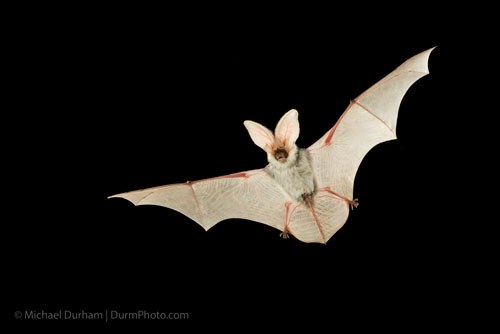 Spotted Bat. Photo: Michael Durham.
Spotted Bat. Photo: Michael Durham. - Pallid bat (Antrozous pallidus). The pallid bat is one of central Oregon's largest bats and specializes on capturing crickets, scorpions, and centipedes. It has huge ears like the spotted bat but is otherwise distinctive because its fur is a yellow tawny color. Pallid bats are also desert specialists and are very social, forming large maternity colonies in the desert canyon cliff walls. Learn more about pallid bats.
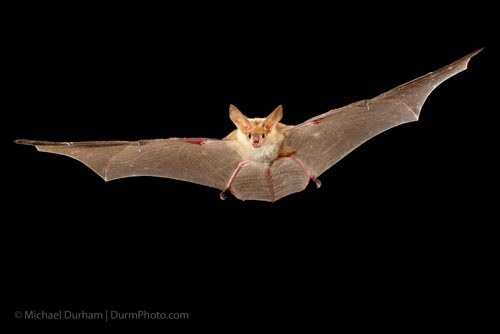 Pallid bat. Photo: Michael Durham.
Pallid bat. Photo: Michael Durham. - Canyon bat (Parastrellus hesperus). The canyon bat, formerly called the western pipistrelle, is the smallest bat north of Mexico. It too is a desert dweller that comes out early in the evening so it is frequently seen flitting about chasing small flies and mosquitoes in, of course, desert canyons. It can sometimes be seen during the day along the lower Deschutes and John Day rivers sneaking out of its cliff crevice roost for a quick drink. Learn more about canyon bats.
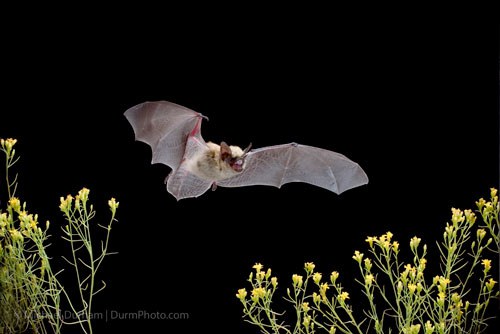 Canyon bat. Photo: Michael Durham.
Canyon bat. Photo: Michael Durham. - Hoary bat (Lasiurus cinereus). The hoary bat is the largest bat in Oregon and is migratory, arriving the region in spring and departing in fall, rather than staying to hibernate. The hoary bat is a very strong, fast flying bat that sometimes can be seen chasing other bats (although not to eat them, it too is an insect eater). Hoary bats are unique because they roost in the foliage of cottonwoods and other deciduous trees. They are not desert specialists but do frequent desert canyons as well as the west-side forests of Oregon. Learn more about hoary bats.
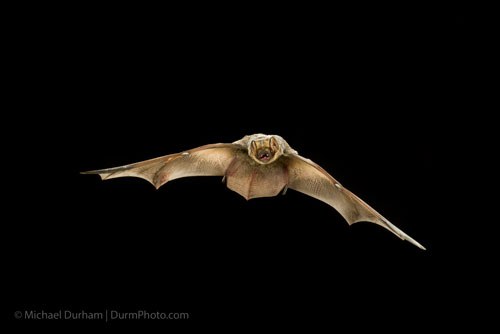 Hoary bat. Photo: Michael Durham.
Hoary bat. Photo: Michael Durham. - Little brown bat (Myotis lucifugus). The little brown bat has been considered America's most widespread and common bat. However, in recent years this perception has been forcibly changed as little brown bat populations in eastern North America have been decimated by the bat disease white-nose syndrome. So far, little brown bats in Oregon appear not to have been infected by the disease although it has spread in to Washington so it may only be a matter of time. Little brown bats are one of several plain brown bats with indistinct markings that live in Central Oregon. Little brown bats are commensal with humans, meaning that they will share our residences, sometimes roosting in attics, or hanging out under porch eaves while resting in between foraging bouts. Learn more about little brown bats.
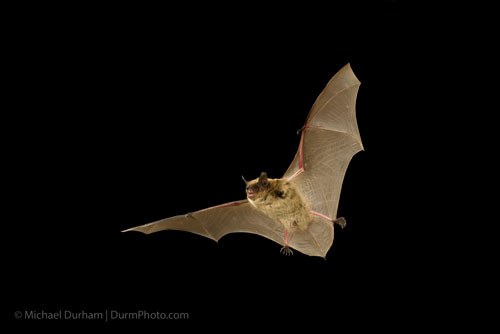 Little brown bat. Photo: Michael Durham.
Little brown bat. Photo: Michael Durham.
Learn more about:
- The role bats play in nature: pest control, pollination, seed dispersal and more!
- Reasons bats are cool!
- Get involved with bat conservation.
